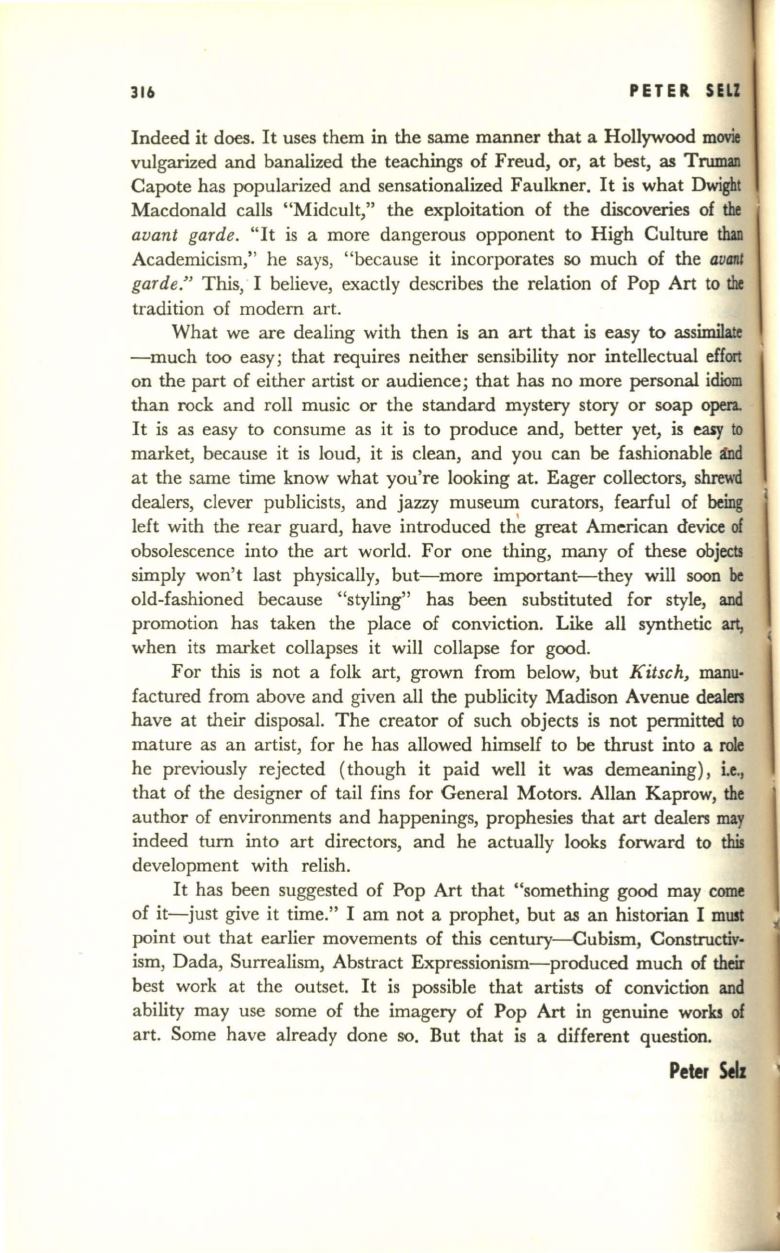
316
PETER SELZ
Indeed it does. It uses them in the same manner that a Hollywood movie
vulgarized and banalized the teachings of Freud, or, at best, as Truman
Capote has popularized and sensationalized Faulkner. It is what
Dwight
Macdonald calls "Midcult," the exploitation of the discoveries of
the
avant garde.
"It is a more dangerous opponent to High Culture
thaD
Academicism," he says, "because it incorporates so much of the
avant
garde."
This, I believe, exactly describes the relation of Pop Art to
the
tradition of modern art.
What we are dealing with then is an art that is easy to assimilate
-much too easy; that requires neither sensibility nor intellectual effort
on the part of either artist or audience; that has no more personal idiom
than rock and roll music or the standard mystery story or soap opera.
It is as easy to consume as it is to produce and, better yet, is
easy
to
market, because it is loud, it is clean, and you can be fashionable Ind
at the same time know what you're looking at. Eager collectors,
shrewd
dealers, clever publicists, and jazzy museum curators, fearful of
being
left with the rear guard, have introduced
th~
great American device of
obsolescence into the art world. For one thing, many of these objects
simply won't last physically, but-more important-they will soon
be
old-fashioned because "styling" has been substituted for style,
and
promotion has taken the place of conviction. Like all synthetic
art,
when its market collapses it will collapse for good.
For this is not a folk art, grown from below, but
Kitsch,
manu–
factured from above and given all the publicity Madison Avenue dealen
have at their disposal. The creator of such objects is not permitted
to
mature as an artist, for he has allowed himself to be thrust into a role
he previously rejected (though it paid well it was demeaning), i.e.,
that of the designer of tail fins for General Motors. Allan Kaprow,
the
author of environments and happenings, prophesies that art dealers may
indeed turn into art directors, and he actually looks forward to
this
development with relish.
It has been suggested of Pop Art that "something good may come
of it-just give it time." I am not a prophet, but as an historian I must
point out that earlier movements of this century--Cubism, Constructiv–
ism, Dada, Surrealism, Abstract Expressionism-produced much of
their
best work at the outset. It is possible that artists of conviction
and
ability may use some of the imagery of Pop Art in genuine works of
art. Some have already done so. But that is a different question.
Peter
SeIz


